Learning the Art of Electronics Instruments and Dc Circuits
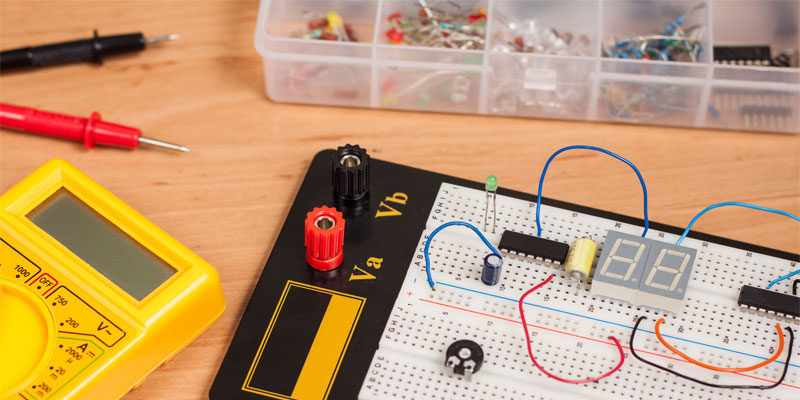
Learning about basic electronics and creating your own projects is a lot easier than you may think. In this tutorial, we're going to requite you a cursory overview of common electronic components and explicate what their functions are. You will and then learn about schematic diagrams and how they are used to blueprint and build circuits. And finally, y'all will put this information to employ by creating your offset basic circuit.
Gratuitous EBOOK (PDF) – Makerspace Info Bundle
Electronic Workbench
Before you get started, brand certain your electronic workbench is properly gear up up. The work area doesn't need to be fancy and you could evenbuild your ain electronic workbench.
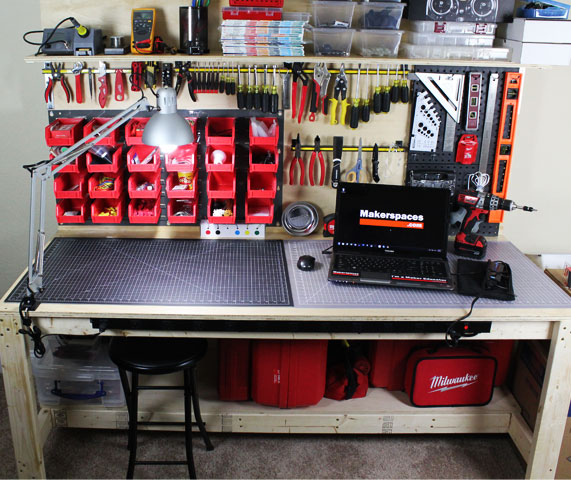
Storage
Electronic components can be small and it'south a good idea to continue everything organized. The almost pop choice is to utilise articulate plastic storage boxes for storing parts. In add-on, you could utilize plastic storage bins that hang from a rack or fit on a shelf.
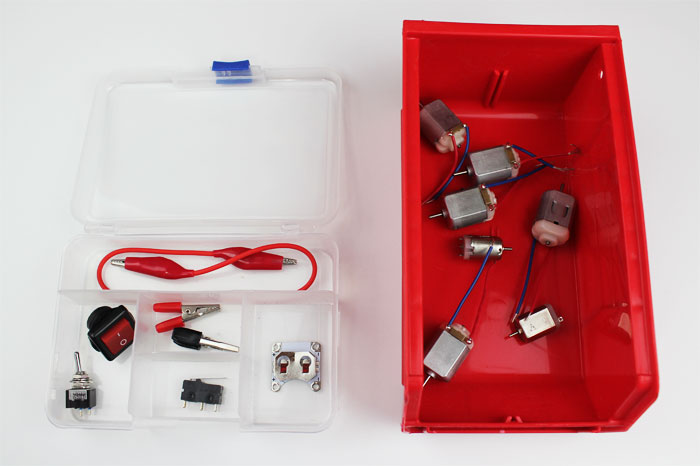
Tools
Now that you have a good workspace ready up, it'due south time to stock it with the proper tools and equipment. This isn't a complete list but it does highlight the most common items used in electronics.
Breadboard
Breadboards are an essential tool for prototyping and building temporary circuits. These boards comprise holes for inserting wire and components. Because of their temporary nature, they permit you to create circuits without soldering. The holes in a breadboard are continued in rows both horizontally and vertically as shown below.
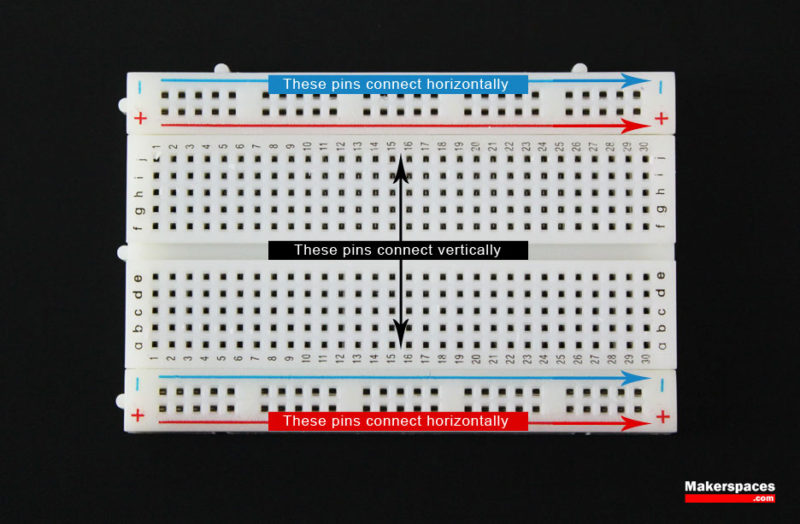
Digital Multimeter
A multimeter is a device that'due south used to measure electric electric current (amps), voltage (volts) and resistance (ohms). Information technology'southward a corking for troubleshooting circuits and is capable of measuring both Ac and DC voltage. Check out this postal service for more info on how to apply a multimeter.
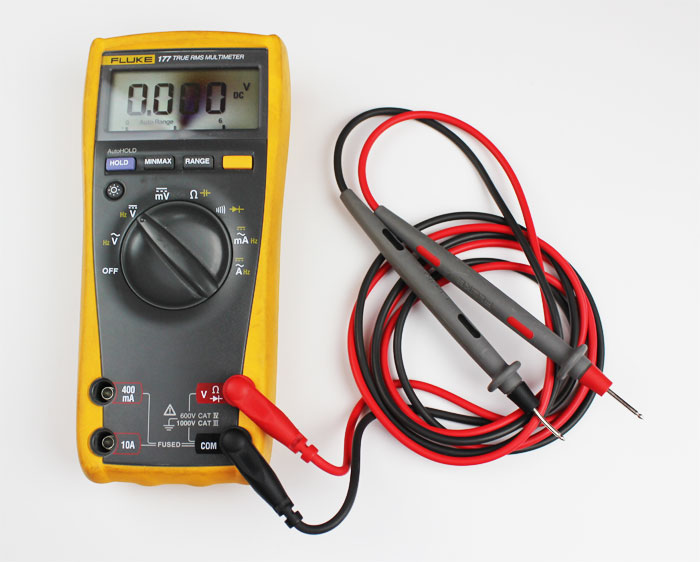
Bombardment Holders
A battery holder is a plastic case that holds batteries from 9V to AA. Some holders are enclosed and may have an on/off switch built in.
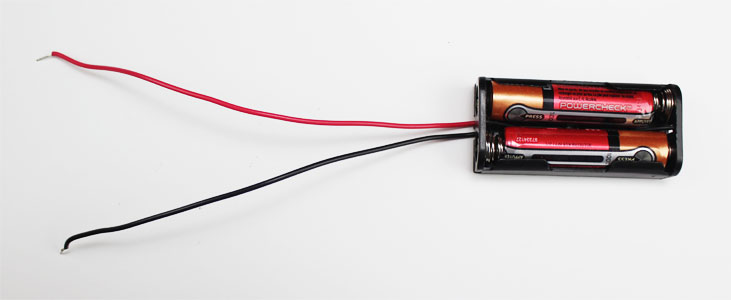
Examination Leads (Alligator Clips)
Examination leads are great for connecting components together to test a circuit without the demand for soldering.
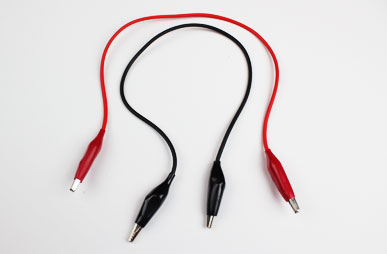
Wire Cutter
Wire cutters are essential for stripping stranded and solid copper wire.
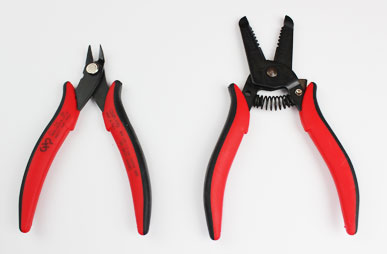
Precision Screwdriver Prepare
Precision screwdrivers are besides known every bit jeweler's screwdrivers and usually come up as a set. The advantage of these over normal screwdrivers is the precision tips of each commuter. These are very handy when working with electronics that contain tiny screws.
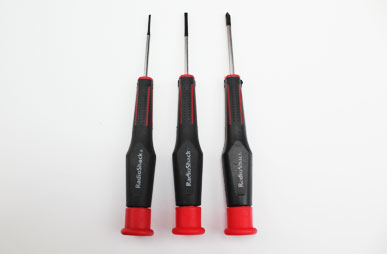
Helping 3rd Mitt
When working with electronics, it seems you never have enough easily to hold everything. This is where the helping hand (3rd paw) comes in. Great for property circuit boards or wire when soldering or tinning.
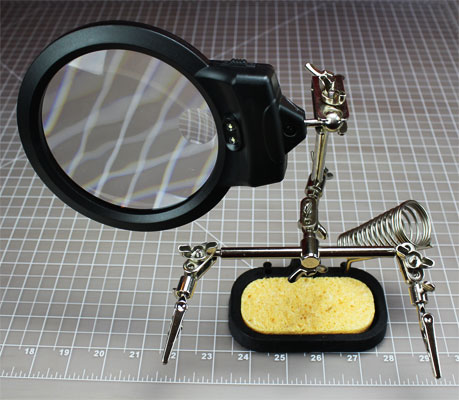
Oestrus Gun
A heat gun is used to shrink plastic tubing known asheat shrink to aid protect exposed wire. Rut shrink has been called the duct tape of electronics and comes in handy in a broad variety of applications.
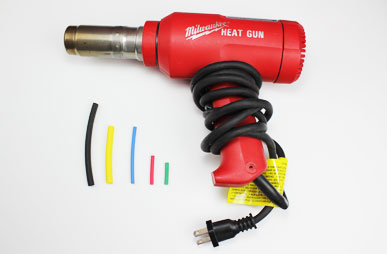
Jumper Wire
These wires are used with breadboard and evolution boards and are generally 22-28 AWG solid core wire. Jumper wires tin can have male or female ends depending on how they need to exist used.
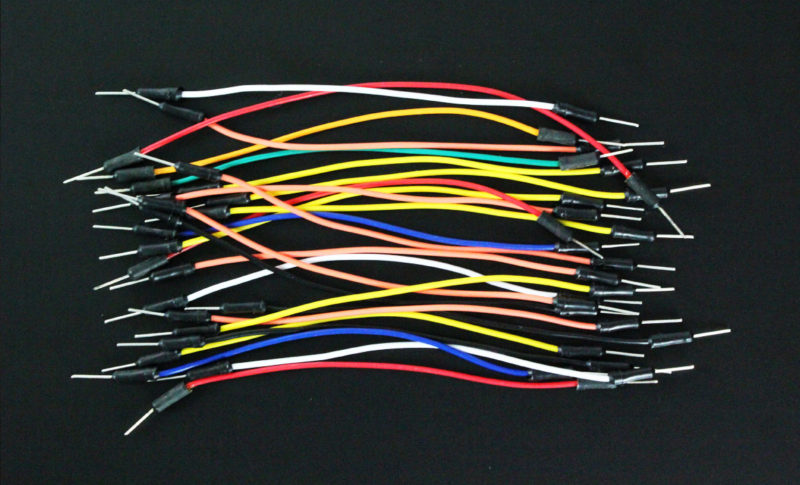
Soldering Iron
When it fourth dimension to create a permanent circuit, you lot'll desire to solder the parts together. To do this, a soldering iron is the tool you would use. Of course a soldering iron isn't any skilful unless y'all have solder to get with it. You can cull leaded or atomic number 82-gratis solder in a few diameters.
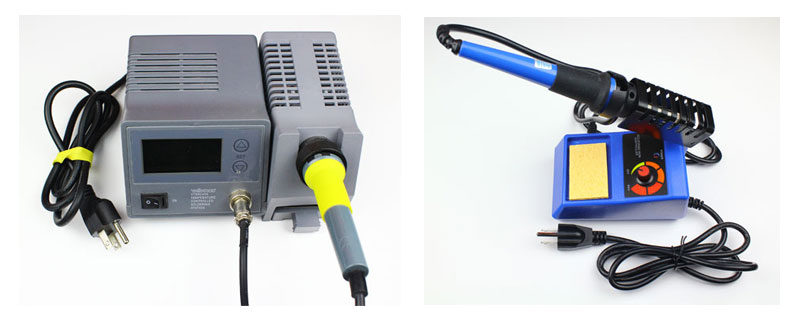
Electronic Components
Now its time to talk about the different components that brand your electronic projects come to life. Below is a quick breakdown of the most common components and functions they perform.
Switch
Switches can come in many forms such as pushbutton, rocker, momentary and others. Their basic role is to interrupt electric electric current by turning a excursion on or off.

Resistor
Resistors are used to resist the flow of electric current or to control the voltage in a excursion. The amount of resistance that a resistor offers is measured in Ohms. Near resistors have colored stripes on the outside and this code will tell you lot it'southward value of resistance. You can employ a multimeter or Digikey's resistor color code computer to make up one's mind the value of a resistor.

Variable Resistor (Potentiometer)
A variable resistor is besides known as a potentiometer. These components can be constitute in devices such as a low-cal dimmer or volume control for a radio. When you plow the shaft of a potentiometer the resistance changes in the excursion.

Light-Dependent Resistor (LDR)
A light-dependent resistor is likewise a variable resistor just is controlled past the low-cal versus turning a knob. The resistance in the excursion changes with the intensity of the light. These are often plant in exterior lights that automatically plow on at dusk and off at dawn.
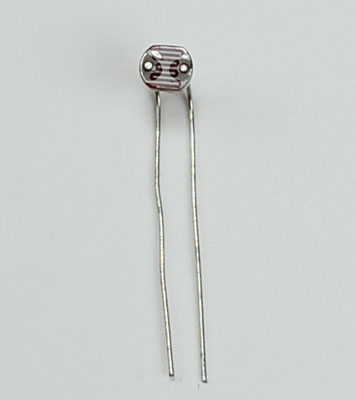
Capacitor
Capacitors store electricity and then discharges it back into the circuit when there is a drop in voltage. A capacitor is like a rechargeable battery and can be charged then discharged. The value is measured in F (Farad), nano Farad (nF) or pico Farad (pF) range.

Diode
A diode allows electricity to flow in ane direction and blocks it from flowing the reverse manner. The diode'south primary role is to route electricity from taking an unwanted path within the circuit.

Light-Emitting Diode (LED)
A light-emitting diode is like a standard diode in the fact that electrical electric current only flows in one direction. The main difference is an LED will emit light when electricity flows through information technology. Inside an LED in that location is an anode and cathode. Current always flows from the anode (+) to the cathode (-) and never in the contrary direction. The longer leg of the LED is the positive (anode) side.
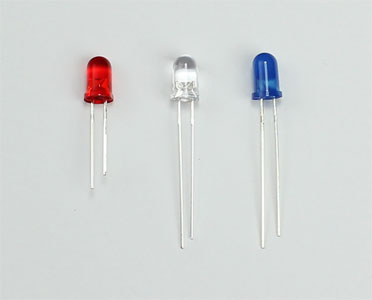
Transistor
Transistor are tiny switches that turn a electric current on or off when triggered by an electric betoken. In addition to being a switch, it can likewise exist used to dilate electronic signals. A transistor is similar to a relay except with no moving parts.

Relay
A relay is an electrically operated switch that opens or closes when ability is applied. Inside a relay is an electromagnet which controls a mechanical switch.

Integrated Circuit (IC)
An integrated circuit is a circuit that's been reduced in size to fit within a tiny chip. This circuit contains electronic components like resistors and capacitors merely on a much smaller scale. Integrated circuits come in unlike variations such as 555 timers, voltage regulators, microcontrollers and many more. Each pivot on an IC is unique in terms of it's part.
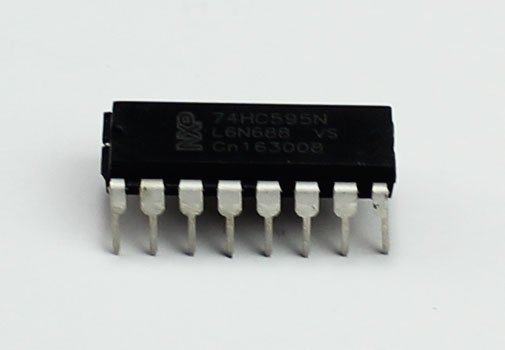
What Is A Excursion?
Earlier y'all blueprint an electronic project, yous demand to know what a circuit is and how to create ane properly.
An electronic excursion is a circular path of conductors by which electrical current can menstruum. A airtight circuit is like a circle because it starts and ends at the same point forming a complete loop. Furthermore, a closed circuit allows electricity to menstruum from the (+) power to the (-) ground uninterrupted.
In contrast, if there is whatever break in the menstruation of electricity, this is known as an open circuit. As shown below, a switch in a excursion tin can cause it to be open or closed depending on it's position.
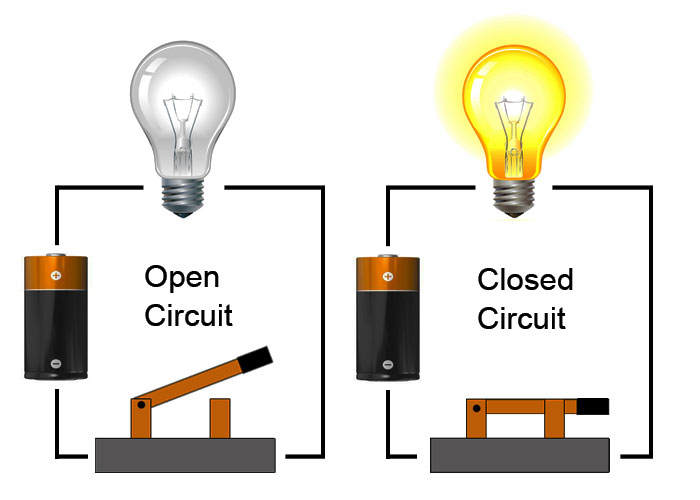
All circuits need to accept three basic elements. These elements are a voltage source, conductive path and a load.
The voltage source, such as a battery, is needed in lodge to crusade the current to period through the circuit. In add-on, there needs to be a conductive path that provides a route for the electricity to period. Finally, a proper excursion needs a load that consumes the ability. The load in the above circuit is the lite bulb.
Schematic Diagram
When working with circuits, you lot will often find something called a schematic diagram. These diagrams employ symbols to illustrate what electronic components are used and where they're placed in the circuit. These symbols are graphic representations of the actual electronic components.
Beneath is an example of a schematic that depicts an LED circuit that is controlled past a switch. Information technology contains symbols for an LED, resistor, battery and a switch. By following a schematic diagram, yous are able to know which components to use and where to put them. These schematics are extremely helpful for beginners when first learning circuits.
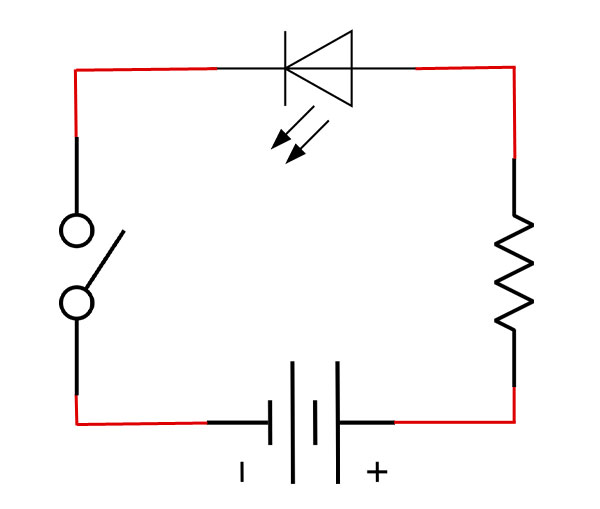
At that place are many types of electronic symbols and they vary slightly between countries. Below are a few of the most commonly used electronic symbols in the Usa.
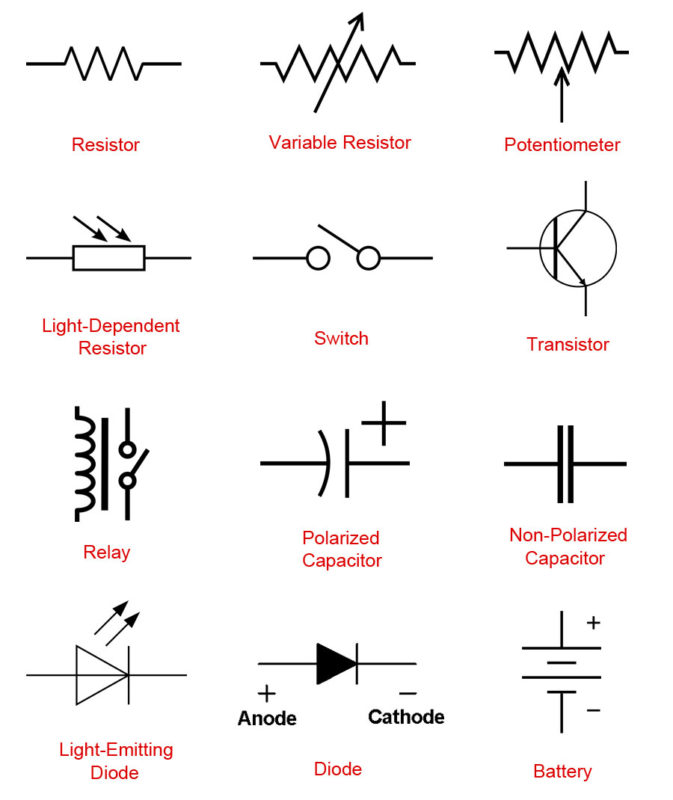
How To Determine A Resistor Size
Resistors are commonly used in electronics projects and it's important to know which size to use. To find the resistor value, yous need to know the voltage and the amps for your LED and battery.
A standard LED generally needs a voltage of around 2V and a current of 20mA or .02A to operate correctly. Next, you lot demand to detect out what voltage your battery is. In this example, we volition exist using a 9V battery. In order to determine the resistor size, we demand to utilize a formula known as Ohm'southward law equally shown below.
Ohm's Constabulary – Resistance (R) = Voltage (Five) / Current (I)
- Resistance is measured in Ohms (Ω)
- Voltage is measured in volts (V)
- Current is measured in amps (A)
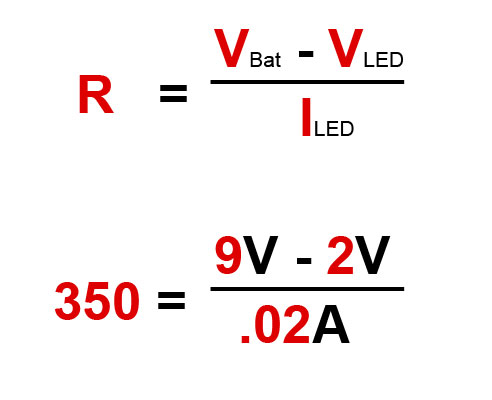
Using Ohm's police force, you need to decrease the LED voltage from the bombardment voltage. This will give you a voltage of 7 which needs to be divided by .02 amps from the LED. This formula shows that you will need a 350 Ω resistor.
As a notation, standard resistors don't come in 350 Ω just are available in 330 Ω which will work fine.
Electronics Projection #one
Now it's time to combine everything you've learned and create a basic circuit. This project is a bully starter project for beginners. We volition be using exam leads to create a temporary circuit without having to solder it together.
Parts Needed:
- 9V Bombardment
- Battery Snap-on Connector
- Exam Leads westward/ Alligator Clips
- 330 Ohm Resistor
- LED – Basic Red 5mm
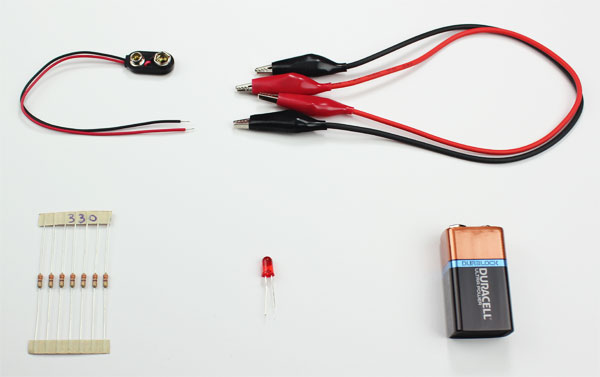
Schematic Diagram
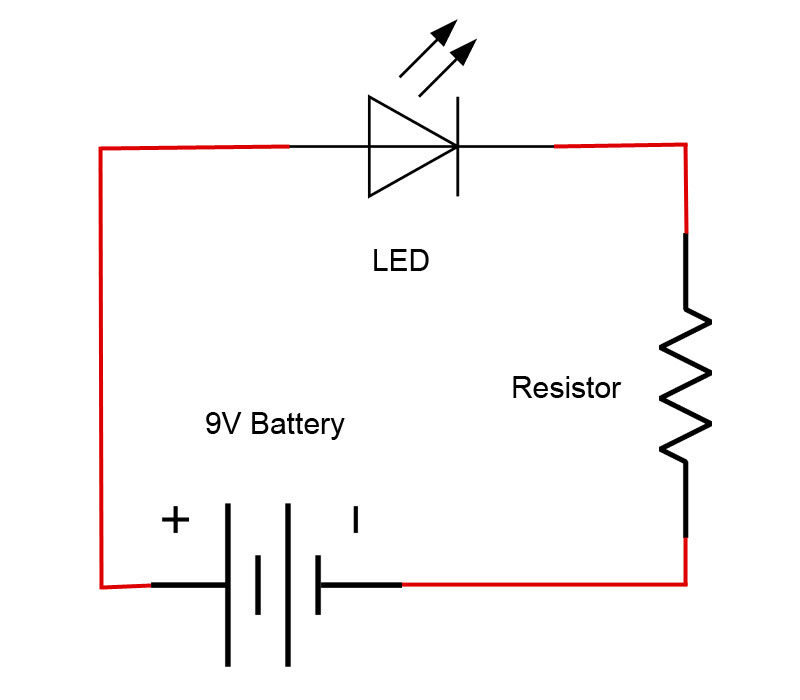
Project Steps
- Attach the battery prune to the summit of the 9V battery.
- Red wire from the battery clip is connected to one alligator clip on the red test pb.
- The other terminate of the red examination lead is connected to the long leg (+) of the LED.
- Connect i alligator clip from black exam lead to the short leg (-) of the LED.
- The other cease of the black test lead is clipped to i leg of the 330 Ω resistor.
- Clip ane side of the other black test lead to the other leg of the 330 Ω resistor.
- The contrary end of the black test atomic number 82 is connected to the blackness battery wire.
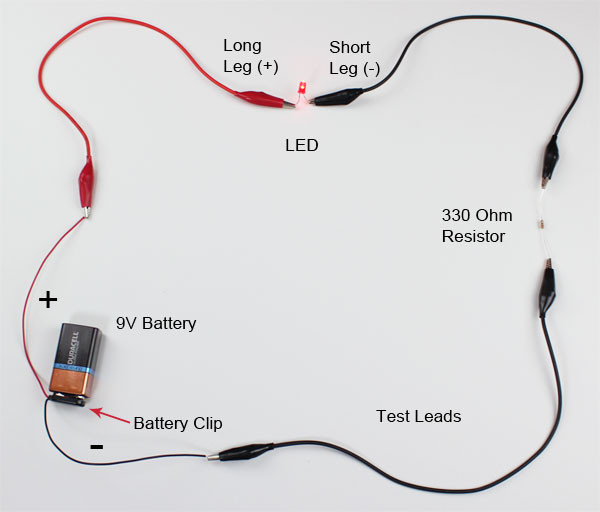
Of import – Never connect an LED straight to a 9V bombardment without a resistor in the circuit. Doing so with harm/destroy the LED. Y'all tin still connect an LED to a 3V or smaller battery without a resistor.
How To Employ A Breadboard
Another manner to create and test a excursion is to build it on a breadboard. These boards are essential for testing and prototyping circuits because no soldering is needed. Components and wires are pushed into the holes to form a temporary circuit. Because it's not permanent, you can experiment and brand changes until the desired outcome is reached.
Below the holes of each row are metal clips that connect the holes to each other. The middle rows run vertically as shown while the outside columns are connected horizontally. These exterior columns are called ability rail and are used to receive and provide power to the board.

Breadboards will need to have power supplied to them and this can be done in a few ways. One of the easiest way is to plug the wires from a battery holder into the power rails. This volition supply voltage to the rail it's plugged into only.
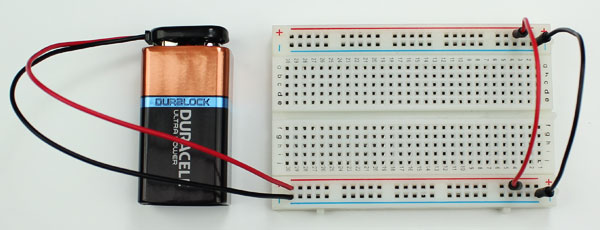
To ability both rail, yous volition demand to employ a jumper wire from the (+) and (-) to the rail on the opposite side.
Electronics Project #2
Now we're going to learn how to create a circuit on a breadboard. This circuit is the exact same 1 we did earlier but we won't exist using the examination leads.
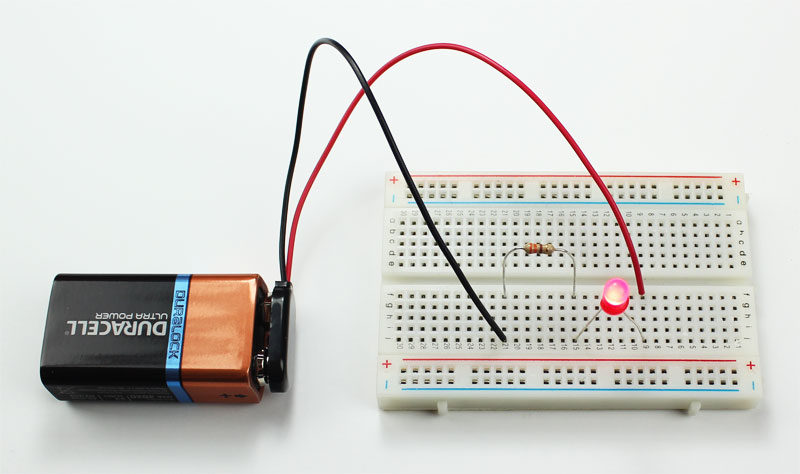
Parts Needed:
- 9V Battery
- Battery Snap-on Connector
- 330 Ohm Resistor
- LED – Basic Blood-red 5mm
- Breadboard- Half Size
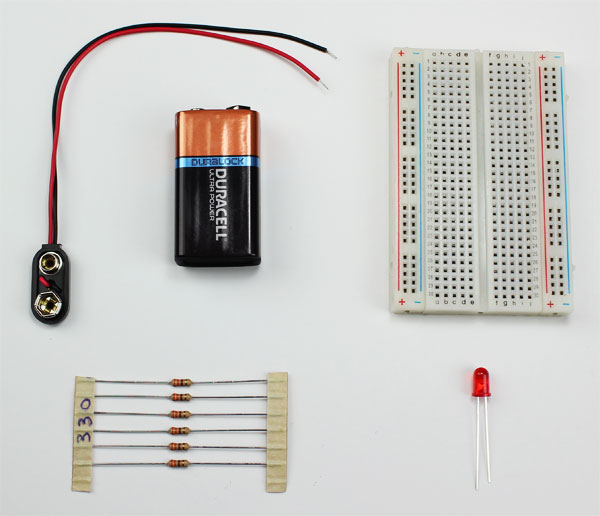
Schematic Diagram

Projection Steps
- Attach the bombardment clip to the top of the 9V battery.
- Place the red wire from the battery prune into F9 of the breadboard.
- Insert the black wire from the bombardment prune into J21 of the breadboard.
- Bend the legs of the 330 Ω resistor and place ane leg into F21.
- Place the other leg of the resistor into F15.
- Insert the brusk leg of the LED into J15 and the long leg into J9.
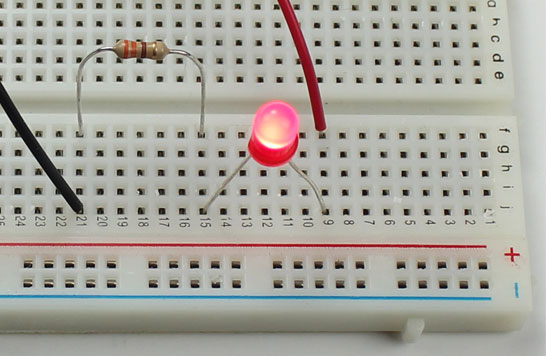
The red arrows in the image beneath assistance to show how electricity is flowing in this circuit. All components are connected to each other in a circle only similar when we used the test leads.
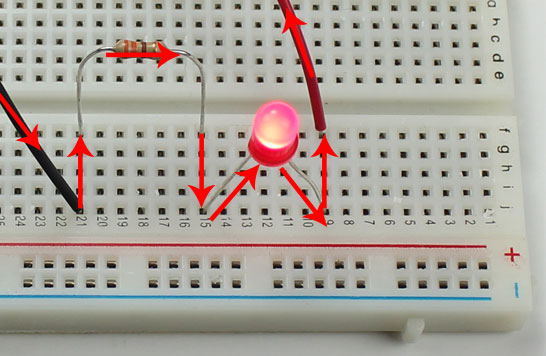

Important – Never connect an LED straight to a 9V bombardment without a resistor in the circuit. Doing so with damage/destroy the LED.
How To Solder
If you desire to brand your excursion permanent, yous'll need to solder it together. For an in-depth tutorial on soldering electronics, view our post How To Solderfor a complete pace-by-step guide.
Electronics Supply
There are a lot of great places online to find electronic components, parts and tools. Below is a listing of our favorite places to store for electronics.
- Mouser Electronics
- DigiKey
- Newark Element 14
- Sparkfun Electronics
- Adafruit
- All Electronics
- MCM Electronics
- Jameco
Source: https://www.makerspaces.com/basic-electronics/
0 Response to "Learning the Art of Electronics Instruments and Dc Circuits"
Postar um comentário